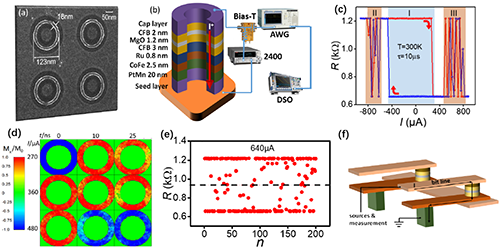Research progress of a true random number generator based on nano-ring shaped magnetic tunnel junction
Date:01-07-2019 Print
In the era of big data, random numbers have been indispensably used in a wide variety of applications, including information encryption in the field of communication, statistics in scientific research, random process in gambling and random key in the information security. Pseudorandom number generators (PRNGs), which generate a sequence of numbers from a seed using a computer program, are often used because of their high operating rate of about 100 Gbps. However, there exist severe security limitations for the PRNGs because the generated sequences can be decoded mathematically. Thus, true random number generators (TRNGs) based on physical processes with complete indeterminacy are desirable. Therefore, how to generate high-quality true random numbers with high generation rate and incoherence has become an important problem in the field of random number research.
The research team of M02 Xiufeng Han’s group, State Key Laboratory of Magnetics, Institute of Physics, Chinese Academy of Sciences, has been working on the research of spintronic materials, physics and devices. In 2006, M02 group has successfully fabricated the nano-ring magnetic tunnel junction (NR-MTJ). Furthermore, they have realized the magnetization switching and oscillating in the NR-MTJ induced by spin transfer torque (STT) effect which can be used in the MRAM and spin nano oscillator devices [Appl. Phys. Lett. 91 (2007) 122511; Phys. Rev. B 77 (2008) 134432; Phys. Rev. B 77 (2008) 224432;J. Appl. Phys. 103 (2008) 07E933 (Invited); Phys. Rev. Appl. 9 (2018) 454013; Phys. Rev. Appl. 10 (2018) 044067]. The research and experience of the NR-MTJ and the nano-ring spin devices also provide the material and physical foundation for the further development of the new spin random number generator using NR-MTJ.
Recently, M02 group has observed and investigated the random back hopping phenomenon in NR-MTJs. The distribution of resistance in the back hopping current range is totally random, which is taken as the basis of the TRNG. It is found that the probability of the emergence of back hopping depends on the measurement temperature T and current pulse width. First, the NR-MTJs with ring width and outer diameter of 18 nm and 123nm have been fabricated, as shown in Figure 1(a). At low current, spin transfer torque (STT) plays the role of a driving force that stably sets the two magnetic layers in either parallel (P) or antiparallel (AP) states, which corresponds to low and high resistances, respectively. With further increase of current, the magnetization will be driven deviating from the stable state and fluctuates between P and AP states, as shown in Figure 1(c). All these experimental results are well reproduced by Spin dynamics simulations, which also explains the mechanism of back hopping from the perspective of energy. Spin dynamics simulations show that back hopping phenomenon could be reproduced by considering the combination of in-plane STT effect and thermal noise. That indicates the emerging of the back hopping is due to both STT and thermal perturbation.
Finally, the reliability of randomness of the number sequence (20000 numbers) is examined according to the randomness testing suites of FIPS 140–1 and STS 2.1.1, issued by the National Institute of Standards and Technology (NIST). The results of both suites show that all the tests have been passed, indicating high quality of the randomness for the number sequence. Besides, analogous to MRAM, if a series of NR-MTJs are arranged in parallel connection as shown in Fig. 4(d), in general, a random number sequence containing 2N numbers can be obtained. Thus, the TRNG generating rate can be as high as ~100MHz, even ~1GHz with an infinite sequence length, which can cover most applications.
Related work has been published in Applied Physics Letters as an Editor’s Pick [J. Y. Qin, X. F. Han et al. Thermally activated magnetization back-hopping based true random number generator in nano-ring magnetic tunnel junctions. Appl. Phys. Lett. 114 (2019) 112401.]. The research was supported by the National Natural Science Foundation of China (NSFC), the Ministry of Science and Technology (MOST) and the Chinese Academy of Sciences.
 |
| 图1. (a) The SEM image of the NR-MTJs; (b) The multilayer structure and the setup of the measurement system; (c) Current induced magnetization switching at room temperature in NR-MTJs; (d) The magnetization and the domain motion under different currents in NR-MTJs obtained by spin dynamics simulations; (e) Distribution of the resistance in the back hopping region under a bias current; (f) Schematic diagram of a TRNG device employing an array of NR-MTJs. |

